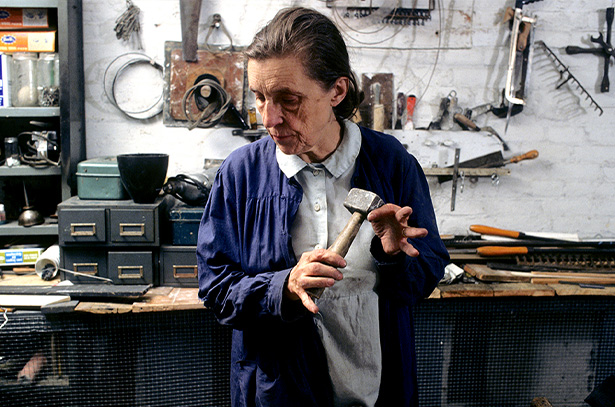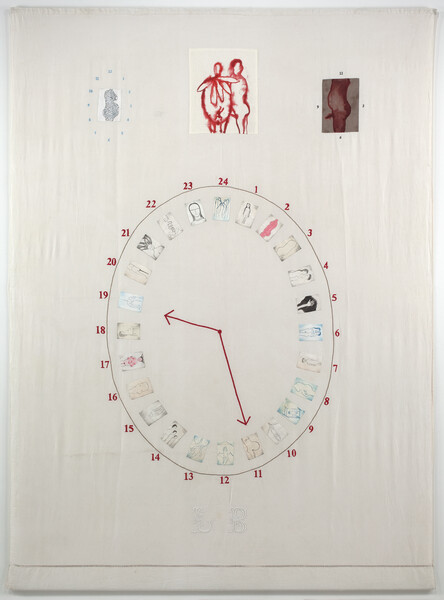
Louise Bourgeois
Self Portrait
26 June 2020
Online Exhibition
Composed on an old bedspread embroidered with the initials L.B., the twenty-four individually printed drypoint images of ‘Self Portrait’ are collaged and stitched at each hour, marking various events from Bourgeois’s life and symbolizing distinct psychological states and relationships in chronological order. Three additional images positioned above the clock signify the emotional hierarchy of love and family. The work is a meditation on the passage of time through a unique visual language in which Bourgeois condenses her memories into images so that together they convey her life story. Bourgeois consistently revisited her past as a means of understanding her present. Here, the formal structure of the clock provides a rhythmic and conscious progression, counteracting the instability of the unconscious and its shifting psychic terrain.
As a girl, woman, wife, mother, and artist, the trajectory of Bourgeois’s life can be traced through her physical and emotional transformation as the hours on the clock advance. The first hour shows the artist as a young girl; the following images represent the girl’s rites of passage as she matures and becomes aware of her sexuality. She meets her husband, the art historian Robert Goldwater; their marriage is symbolized by a hand with a wedding ring. As time passes, she adopts a child (her son Michel), gives birth to two more sons, and has a family of her own (as shown in ‘Three Sons’ at hour 14). The relationships she creates – with Robert, with her children – are inflected and shaped by the residual effects of a traumatic childhood, her ingrained fear of abandonment and separation, and ultimately her need for love and personal connection. The importance of family is represented by the center panel above the clock, in which the female figure’s five breasts symbolize the family of five that Bourgeois had, while also mirroring the family of five in which she was raised. In this image, she identified herself as the baby in the womb, simultaneously representing herself and doubling back in time to represent her parents.
Bourgeois’s psychological states evolved as memories and past experiences were manifested in depression, insomnia, an interest in hysteria, and a deep engagement with psychoanalysis. While some images on the clock are evocative of particular art works, all serve to provide a sense of her life through the imagery she created, instigated by personal feelings of anxiety, guilt, fear, atonement, and reparation, and played out in her relationships with others. As the clock’s hands return to the top of the dial, Bourgeois depicts herself at the end of her life. The final hour reveals a blue drypoint print of ‘Maman,’ a monumental spider figure symbolic of both Bourgeois’s mother, a weaver, and of her own artistic practice: just as a spider makes its web from its body, Bourgeois felt she made sculpture through her body. By ending with this image, Bourgeois returns to the beginning – to her mother and, ultimately, to the womb, where she will continue again, cyclically, to the young girl. This vividly autobiographical work catalogs the emotions underlying and guiding the act of artmaking, the impulses that allowed Bourgeois to make sense of both her biography and inner self.
As the artist wrote, ‘My life is a succession of quarters of an hour which are spent in a succession of square meters... I’ve schlepped Louise Bourgeois around with me for more than 40 years. every day brought its wound and I carried my wounds ceaselessly, without remission, like a hide perforated beyond hope of repair. I am a collection of wooden pearls never threaded...’
The digital presentation on Hauser & Wirth’s website will allow visitors to explore ‘Self Portrait’ (2009) in great depth through a series of archival images and films, expanding and deepening our understanding of Bourgeois’s significance in 20th century art.
About the Artist

Louise Bourgeois
Born in France in 1911, and working in America from 1938 until her death in 2010, Louise Bourgeois is recognized as one of the most important and influential artists of the 20th Century. For over seven decades, Bourgeois’s creative process was fueled by an introspective reality, often rooted in cathartic re-visitations of early childhood trauma and frank examinations of female sexuality. Articulated by recurrent motifs (including body parts, houses and spiders), personal symbolism and psychological release, the conceptual and stylistic complexity of Bourgeois’s oeuvre—employing a variety of genres, media and materials—plays upon the powers of association, memory, fantasy, and fear.
Bourgeois’s work is inextricably entwined with her life and experiences: fathoming the depths of emotion and psychology across two- and three-dimensional planes of expression. ‘Art,’ as she once remarked in an interview, ‘is the experience, the re-experience of a trauma.’ Arising from distinct and highly individualized processes of conceptualization, Bourgeois's multiplicity of forms and materials enact a perpetual play: at once embedding and conjuring emotions, only to dispel and disperse their psychological grasp. Employing motifs, dramatic colors, dense skeins of thread, and vast variety of media, Bourgeois's distinctive symbolic code enmeshes the complexities of the human experience and individual introspection.
Rather than pursuing formalist concerns for their own sake, Bourgeois endeavored to find the most appropriate means of expressing her ideas and emotions, combining a wide range of materials—variously, fabric, plaster, latex, marble and bronze—with an endless repertoire of found objects. Although her oeuvre traverses the realms of painting, drawing, printmaking, and performance, Bourgeois remains best known for her work in sculpture.
Bourgeois’s early works include her distinct 'Personages' from the late 1940s and early 1950s; a series of free-standing sculptures which reference the human figure and various urban structures, including skyscrapers. The ‘Personages’ served as physical surrogates for the friends and family Bourgeois had left behind in France, while also highlighting an interest in architecture dating back to her childhood. Her installation of these sculptures as clustered ‘environments’ in 1949 and 1950 foreshadowed the immersive encounters of installation art twenty years before the genre’s rise to prominence.
Bourgeois’s work was included in the seminal exhibition ‘Eccentric Abstraction,’ curated by Lucy Lippard for New York's Fischbach Gallery in 1966. Major breakthroughs on the international scene followed with The Museum of Modern Art in New York's 1982 retrospective of her work; Bourgeois's participation in Documenta IX in 1992; and her representation of the United States at the 45th Venice Biennale in 1993.
In 2001, Bourgeois was the first artist commissioned to fill the Tate Modern’s cavernous Turbine Hall. The Tate Modern’s 2007 retrospective of her works, which subsequently traveled to the Centre Pompidou in Paris; The Guggenheim Museum in New York; The Museum of Contemporary Art in Los Angeles; and The Hirshhorn Museum & Sculpture Garden in Washington D.C., cemented her legacy as a foremost grande dame of late Modernism.
Header image: Louise Bourgeois, ARCHED FIGURE, 1993 © The Easton Foundation/VAGA, NY, Photo: Christopher Burke
Current Exhibitions
1 / 12













